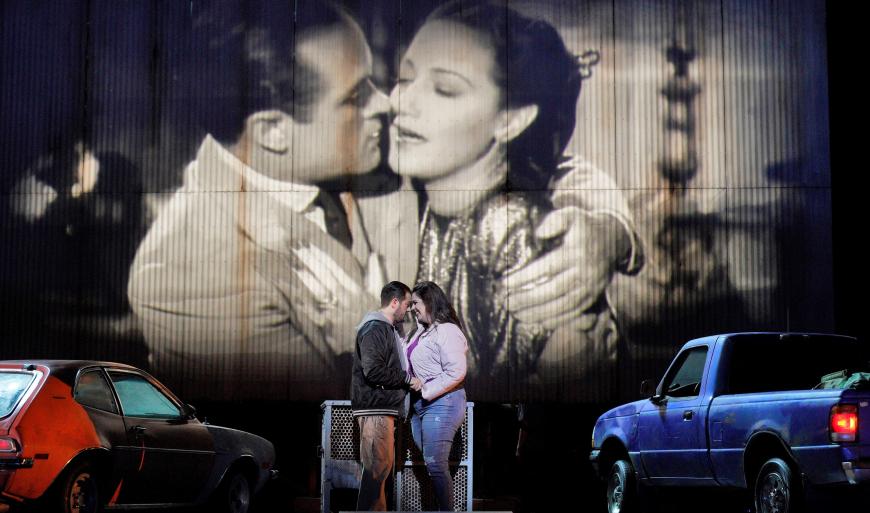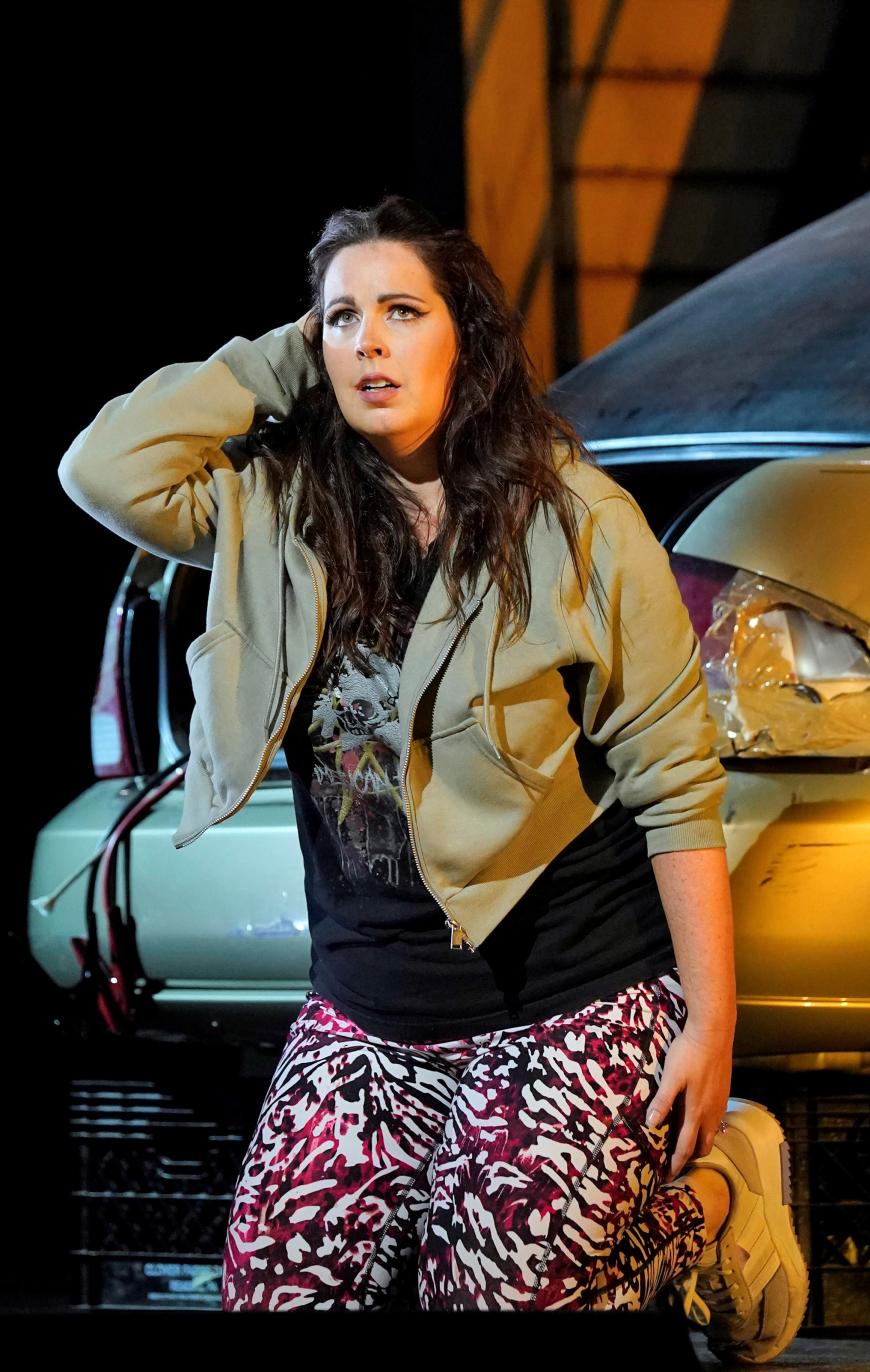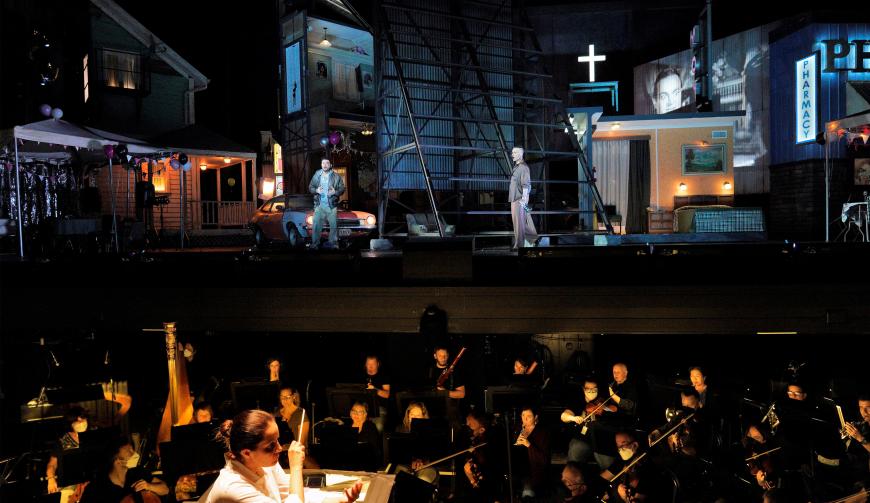
Last week, Gaetano Donizetti went regie in Los Angeles. First, the plucky Pacific Opera Project sent L’elisir d’amore into a 1950s Happy Days-style diner, complete with Little Richard, The Fonz, and rock ’n’ roll lyrics in the supertitles. Then, Los Angeles Opera gave Donizetti’s tragic side an update all the way into 2022 and on a grand scale, with Lucia di Lammermoor opening its season Saturday night, Sept. 17.
Poor Gaetano is probably spinning around somewhere. But then, I would hope not. LA Opera’s production was a delight, a stage director’s romp that actually brought the old warhorse into a new viable focus for a 21st-century American audience. The production previously played at the Metropolitan Opera last spring, and on dramatic and musical grounds, it’s sure to be a hit here.
Credit Australian director Simon Stone —who started directing opera only recently with a production of Erich Korngold’s Die Tote Stadt in Munich in 2019 — for seeing an apt parallel between the declining fortunes of the Ashton family of Lammermoor in 18th-century Scotland and the declining towns of the Rust Belt in the U.S. With that in mind, Stone and scenic designer Lizzie Clachan concocted a painstakingly detailed mockup of what could be any old town from Michigan or Ohio or Pennsylvania that greed and global outsourcing has left behind.

There is the “quickie” mart that just sells junk food and liquor, the pharmacy that dispenses opioids, the pawn shop where locals get cash for their remaining inherited gold and jewelry, the dilapidated motel and rundown drive-in theater. We get the pleasant shock of recognition, for such sights are common even outside the Rust Belt (driving home from the opera that night, I saw a mini-market with yellow signs that could have fit intact into this set). Stone uses the turntable originally installed for the LA Opera Ring cycle to give us continuous revolving tours of the town before bunching all of the landmarks together in Act 3. Meanwhile, the drive-in is continuously showing a 1947 Bob Hope/Dorothy Lamour flick, My Favorite Brunette, a reminder of the town’s rosy past in the middle of the 20th century, as well as a sign that even the old theater can’t afford to keep up with the times.

Lucia becomes a small-town girl living with her financially distressed brother Enrico who tries to run her life. She has an independent streak, she likes to paint, she has a Beyoncé poster on her wall as a role model. Her boyfriend Edgardo rescues her from an attempted mugging during the Prelude but then has to join the Army because there are no jobs in town. Enrico bullies her into an unwanted marriage to a rich guy (Arturo) who promises to revive not only their fortunes but also those of the town. Beset by the forces bearing down on her — inevitably male-controlled — Lucia is seen getting her fix of opioids from the pharmacy, and the implication is that her addiction leads to her madness. Sometimes, her inner thoughts during her arias are projected in black and white onto an overhead screen; at other times, a video crew follows her and other members of the cast around in real time, for no one has privacy anymore in the digital age.
Now all you canary fanciers may be getting impatient with all of this scene setting and social commentary and wondering, “What about the voices? Isn’t Lucia traditionally supposed to be mostly about that?” LA Opera had that base well covered, too. Soprano Amanda Woodbury is in full bloom as Lucia, singing with lustrous tone, turning her trills beautifully, and hitting the treacherous high notes on the button. In the famous, lengthy Act 3 mad scene, her interpretation wasn’t so much that of an insane creature as it was of a woman who had had enough of being put upon in this town.
Madeleine Lyon as Lucia’s friend Alisa was a good contrasting match, with a lighter timbre. Tenor Arturo Chacón-Cruz as Edgardo had command of the line and plenty of stamina for Act 3, though not a ringing tone; Anthony Ciaramitaro in the role of Arturo had him beat in the latter quality. Alexander Birch Elliott conveyed frustrated menace as Enrico, and bass-baritone Eric Owens’s Raimondo was shaky but appropriately so as the aged family priest.

The voices in the even-more-famous sextet did not blend particularly well, but here Lina González-Granados, in her debut as LA Opera’s resident conductor, kept things moving along in a brisk, unforced stream, and the payoff at the close was substantial. Indeed, González-Granados was an impressive accompanying force throughout, following the tempo-bending contours of her singers and whipping up the LA Opera Chorus — depicting lower-middle-class citizens in this heartland town — into a fine frenzy in the finale of Act 2.
Ultimately, Stone’s multilevel concept really works, overcoming the collision with the music and language of bel canto Italian opera to make points that can resonate with an American audience without getting too preachy or overloading the senses. (Is it a greater collision than that of Italian opera and the actual setting in rural Scotland? I think not.) It also provoked a few laughs (not exactly what you would expect at a Lucia performance) — and at the curtain call, at least one booing spectator.
Check this production out (it runs through Oct. 9, with Liv Redpath taking over for Amanda Woodbury starting on Sept. 28). You won’t be bored.




